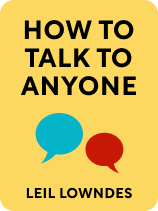

This article is an excerpt from the Shortform book guide to "How to Talk to Anyone" by Leil Lowndes. Shortform has the world's best summaries and analyses of books you should be reading.
Like this article? Sign up for a free trial here .
What does body language say about you? Can people really read your personality based on your body language?
Before you even had the chance to utter your first words, people have already formed opinions about you based on your body language. These impressions may or not be accurate, but they influence how people will react to and treat you.
Here are three foolproof body language tactics to appear confident and encourage a warm response.
Your Body Language Says a Lot About You
You form an instinctive impression of everyone you come across within the first few seconds of seeing them. Before someone gets a chance to utter her first words, you’ve already made assumptions about her personality, her feelings, her confidence levels, and her social or professional status. Most importantly, you’ve already decided whether she’s the type of person that you want to spend time with.
What forms the basis of these assumptions? According to Lowndes, it’s your body language—this includes your posture, how comfortable you appear, the way you smile, and the way you make eye contact. Whether you’re conscious of it or not, your body language constantly emits signals about the way you feel.
Here are three body language tactics you cannot go wrong with, regardless of the context.
1. Don’t Slouch, Maintain a Good Posture
According to Lowndes, people interpret poor posture as an unwelcoming signal. Trying to minimize your physical presence by slumping implies that you’re insecure or ashamed and don’t want to be approached.
On the other hand, people interpret good posture as a welcoming signal because it implies that you’re proud and confident and have nothing to hide. This tricks them into assuming that you’re an accomplished person who deserves their attention.
2. Maintain an Open Stance and Avoid Fidgeting
Lowndes claims that people interpret fidgeting and guarded movements as insincerity because they make you look suspicious and defensive.
On the other hand, Lowndes argues, people interpret a relaxed and open stance as a sign of an honest and welcoming personality because it signals that you’re calm, unafraid of appearing vulnerable (because you have nothing to hide), and approachable. To come across as calm, self-assured, and trustworthy, practice keeping your arms loosely by your sides with your palms and wrists faced upwards. If you’re approached by people you want to talk to, turn your body totally towards them to show them they’ve got your full attention—this implies that you’re happy to be in their company and puts them at ease.
3. Delay Your Smiles and Maintain Eye Contact
According to Lowndes, people don’t respond warmly to quick, instinctive smiles because they interpret them as impersonal—they assume that you’re flashing that smile at anyone you come across. This impels them to respond in kind, by acting detached or distant.
Another behavior that puts people off, Lowndes argues, is a lack of eye contact. Others interpret it as a sign that you’re either distracted or uncomfortable, and this makes it difficult for them to form an emotional connection with you.
To get a warm response, Lowndes suggests that you avoid your instinct to flash a quick smile at anyone you meet. Instead, look the recipient in the eyes, pause briefly, and then let out a big warm smile while maintaining eye contact.

———End of Preview———
Like what you just read? Read the rest of the world's best book summary and analysis of Leil Lowndes's "How to Talk to Anyone" at Shortform .
Here's what you'll find in our full How to Talk to Anyone summary :
- Practical techniques to help you overcome social discomfort
- How to confidently develop new connections
- How to appear more likable without saying a word






